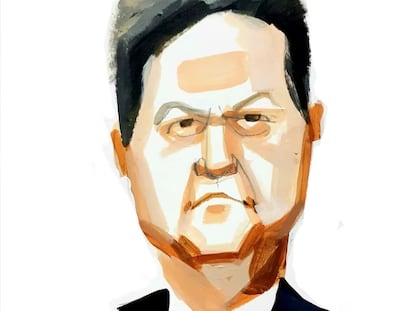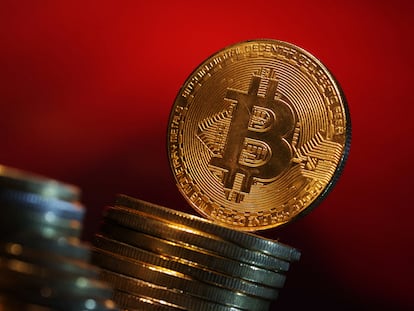The end of the crypto winter looms: These are the tailwinds that are driving Bitcoin again
The most popular cryptocurrency has doubled in price over the last year. Regulatory changes in the U.S. and the foreseeable drop in interest rates have boosted its performance. Young investors tend to be attracted to Bitcoin, often unaware of the risks they’re taking
Bitcoin started 2024 with good news. On January 10, the U.S. Securities and Exchange Commission (SEC) authorized the marketing of exchange-traded funds (ETFs) linked to Bitcoin, a moment long-awaited by followers of the biggest cryptocurrency. It meant putting the purchase of bitcoins just a click away for millions of average investors in the country, who are most likely to place part of their savings in the stock market.
Individuals no longer need to open accounts on cryptocurrency industry platforms — such as Binance or Coinbase — or obtain a digital wallet to store them (a complex process). Now, all they have to do is log on to their online stock trading website of preference and click “buy.”
The moment, however, was somewhat anticlimactic. After the favorable announcement by the SEC, the price of Bitcoin fell, confirming — only for a few hours — the famous saying: “Buy the rumor, sell the news.”
But this was just a bump in the road. For over a year now, the underlying trend shows that Bitcoin is only going up. Its price has exceeded $50,000 and has turned the so-called “crypto winter” into a bad dream. “The approval of the ETF represents the institutionalization of Bitcoin as an asset and exposes the growing acceptance of cryptocurrencies in traditional finance,” says Francisco Maroto, head of Digital Assets and Blockchain at the BBVA Group, one of the largest financial institutions in the world.
Cryptocurrencies are reviled by academics and Nobel Prize winners in Economics. For Paul Krugman, they’re a pyramid scheme; for Joseph Stiglitz, they’re tools for money laundering and tax evasion, while for Robert J. Shiller, they’re part of a speculative bubble, born of an epidemic of enthusiasm. Crypto has also been disparaged by famous investors: “It’s like going to the casino,” Warren Buffett once scoffed. Left for dead every time its price plummets — yet always capable of resurrection — it can be said that Bitcoin has established itself as an investment asset, despite the fact that its daily use as a currency has stagnated.
“Bitcoin isn’t an alternative to fiat money (cash). You shouldn’t look for its use cases there. Bitcoin increases transaction costs for payments and is also inherently volatile,” explains Álvaro D. María, author of The Philosophy of Bitcoin (2024).
Currency exchange
While the idea of bitcoins competing on equal terms with dollars or euros is losing strength — and as the utopia of it being a currency to buy a home, a car, go to the supermarket or make daily payments fades — its position as an investment has been reinforced. “The main value proposition of bitcoin is to park wealth [and build up] value over time. [The fact that] it’s being used more and more for this is essential,” adds Álvaro D. María.
That familiar tune about being a safe place to store wealth is reminiscent of other safe haven assets — those that, no matter what happens, be it an economic crisis or a spike in inflation, will always have some value. Not in vain, there are those who call Bitcoin the new “digital gold.”
Deutsche Bank analyst Marion Labore is one of those who shares this idea, with some nuances. “People have always looked for assets that weren’t controlled by governments. Gold has played this role for centuries. And yes, you could potentially see Bitcoin become the digital gold of the 21st century. Let’s not forget that gold has also been historically volatile. But it’s important to note that Bitcoin is risky: it’s too volatile to be a reliable store of value today. And I expect it to remain very volatile for the foreseeable future,” she states, in a report from the German bank.
Whether or not it’s similar to gold, the truth is that it’s been very profitable for the majority of its holders. While Bitcoin is still below the $69,000 it reached in November 2021 — its all-time high — in the last 12 months, it has more than doubled its price. And, if you go back several years, the returns multiply. Among all investment assets according to market value, Bitcoin would currently occupy tenth place, with a capitalization of more than one trillion dollars, slightly behind Meta, the conglomerate that owns Facebook, Instagram and WhatsApp. The ranking is led by gold, at $13.6 trillion.
Taking advantage of that wave, Coinbase — the American platform for buying and selling cryptocurrencies, now listed on the stock exchange — has doubled its stock market value in six months. It has obtained its first quarterly profits in two years.
When an event as long-awaited and talked-about by the crypto community — such as the arrival of ETFs — finally materializes, the fundamental question is: what now? Francisco Maroto, from BBVA, responds. “In the short-term, positive net investment flows towards these products can be expected, as is already being observed. The next logical step is to move forward with the launch of more ETFs with another cryptoasset (such as ethereum) or baskets of cryptoassets. But it’s very difficult to predict. We have to wait for the regulation to advance and the technology and the market to mature.”
While cryptocurrency has shown unpredictable behavior, there are several reasons to think that good times are ahead for Bitcoin. Just as the hikes in interest rates by central banks recently penalized it, the cuts planned for 2025 favor it.

A recent report entitled “Cryptoassets in the new financial context: interest rates, price and adoption” — by Santiago Carbó, Pedro J. Cuadros-Solas and Francisco Rodríguez — alludes to this increasing correlation. “The economic cycle is beginning to be connected to the behavior of cryptoassets. The evolution of inflation and, in particular, interest rates — in response to generalized price increases — seems to have a relevant impact,” the text concludes. The bottom line is that the more interest rates go up, the less crypto is worth. “High rates make [cryptocurrencies] less attractive to investors, because they can obtain higher returns on public debt, corporate bonds, or bank deposits,” the study notes.
The rate cut is only one element of the resurrection of crypto. “Looking ahead, the most important issue in the bitcoin network continues to be the next ‘halving’ scheduled for April,” says Manuel Villegas, a digital assets analyst at the Swiss bank Julius Baer. “Halving” refers to the reward for Bitcoin mining (validating Bitcoin transactions) being cut in half, which takes place every four years. Why is this important? Because, in theory, it tends to reduce the supply of new bitcoins: as there’s more scarcity, the price rises.
There are those who doubt that this phenomenon is really a driver of the price of Bitcoin. This is because the market — with advance knowledge of its arrival — has already been able to prepare. Or because any unpredicted event can counteract it. However, according to a report from Deutsche Bank, historical patterns indicate that, after previous halvings, the price of Bitcoin has tended to experience an upward trajectory. “In the five days after the first halving on November 28, 2012, it rose more than 8%. After the halving on July 9, 2016, it increased more than 3%. And, in the five days following May 11, 2020, it appreciated by 8.5%,” the report notes.
There are the ETFs, the falling interest rates, the halving… and then, there’s a fourth factor: temptation. For those on the fence about whether to enter the crypto market or not, few things produce more FOMO (fear of missing out) than seeing Bitcoin rise while sitting on the sidelines. Knowing that others are making money (while you’re not) can often result in taking extreme risks. FOMO is, indeed, a powerful accelerator of purchases. The Spanish think tank Funcas cites studies that try to offer a scientific veneer to this intuition, quantifying it like this: an increase of one percentage point in the price of Bitcoin is related to a 0.9% increase in new users after two months.

The push for ETFs isn’t only because of their accessibility. “There’s no doubt that investors around the world have been attracted to the new products because of the lower relative costs involved,” Villegas confirms. The cryptocurrency-focused funds that were launched just after approval by BlackRock and Fidelity are already noticing this fever, with billions of dollars raised in just a few days. The low commissions charged by these instruments make entry barriers more porous, democratizing these investments — for better and for worse.
As Deutsche Bank states in its report, the approval of ETFs is far from being an invitation from the authorities to invest in them. “It’s important to note that the approval of these funds by the SEC came with a warning from its president, Gary Gensler,” the document notes. Gensler emphasized that Bitcoin is “primarily a speculative, volatile asset that’s also used for illicit activity including ransomware, money-laundering [and] sanction evasion… we did not approve or endorse Bitcoin. Investors should remain cautious about the myriad risks associated with bitcoin and products whose value is tied to crypto.” That is, the SEC allows you to buy it, but doesn’t recommend it, as if it were a betting house.
Adolfo Contreras — a senior advisor at Blockstream, a Canadian company that develops a range of products and services for the storage and transfer of bitcoins and other digital assets — believes that the use of cryptocurrency is particularly interesting in countries with few legal protections, or where people distrust their government. “Bitcoin will become a kind of fourth estate. When a government abuses it, citizens will make their assets secret and vote with their feet.” That is, they’ll move where there are more favorable laws towards Bitcoin and where the tax bill is lower.
This libertarian idea of money escaping the confiscatory voracity of governments explains part of the fascination it arouses. “The creators of [cryptocurrency] were cypherpunks. What they intended was to enforce our rights (private property, privacy, etc.) in cyberspace, a domain in which laws don’t work. That’s why Bitcoin works particularly well in jurisdictions where there’s little legal certainty,” Contreras explains.
Within the sector, many believe that the collapse of TerraLuna, Genesis, BlockFi, FTX and many other firms — beyond the significant hole they’ve left in the accounts of millions of clients and the reputational damage done to cryptocurrencies — is simply part of a process of creative destruction that, in the long-term, will serve to clean up the ecosystem. Only those who have made the right moves will survive.
The memory of those bad days seems to have been eclipsed by the latest wave of purchases. “This bull market is going to be even stronger than the one in 2021. Not only because of the price, but because of the entry of the institutional part,” confides Jorge Soriano, CEO of the Spanish cryptocurrency platform Criptan. “The road ahead is long. There are phases that we cannot skip. One of the main triggers will be the integration and adoption by traditional banking.”
However, few financial entities have taken this step. One of them is an Austrian bank — Raiffeisenlandesbank — that proclaims itself to be the first traditional entity within the EU through which it is possible to buy and sell bitcoins, ethereums and other digital currencies. It started allowing these transactions in January.
According to the Funcas document, 5% of Spaniards own some cryptocurrency, a figure similar to the one provided by the National Securities Market Commission (6.8%). But who are these crypto investors? The analysis center says that — as in many upper-income countries — they are young men who study or work, live in large urban areas and enjoy high monthly earnings.
A psychological profile has also been put together: “[These investors] tend to have a higher risk tolerance compared to those who have not purchased cryptocurrencies. They’re more impatient, have lower levels of self-control and are more willing to accept losses on an investment if profits above normal market rates can be expected.”
The golden age of risk
Having surpassed $50,000, the next peak for Bitcoin to beat is the all-time high of $69,000 reached almost two-and-a-half years ago. With the U.S. and Japanese stock markets at record highs — and with some European stock markets, such as Germany’s, also at or near their peaks — risk-lovers are living in a golden age.
When that happens, the word “bubble” soon appears in our vocabulary. But a never-before-seen valuation doesn’t have to imply that the enthusiasm is unjustified. And, for ordinary mortals, anticipating this is practically impossible; we only really know about bubbles when they burst.
Víctor Alvargonzález — the founder of Nextep Finance — gives some clues to identify when a bubble is forming in a certain market. “What we have now isn’t euphoria. Euphoria was experienced in 1987, when Wall Street was the highest-grossing film. Also in 2000, with the [dot-com bubble]. Or with TerraLuna and cryptocurrencies in 2021. To know if that phase has been reached, there are technical and other common signs: when friends start asking about the stock market or cryptocurrencies, as happened with Bitcoin; when you see financial advertising in places where there usually isn’t any, such as on marquees or football stadiums; or when your neighbor brags about his investments.”
This is the modern version of the anecdote attributed to oil magnate John D. Rockefeller. A few days before the stock market crash of 1929, his driver asked him how the stock market was doing… and all his alarm bells went off. If even the chauffeurs were heavily invested in the stock market, things couldn’t end well. We’ll have to pay attention to all the signs.
Sign up for our weekly newsletter to get more English-language news coverage from EL PAÍS USA Edition
Tu suscripción se está usando en otro dispositivo
¿Quieres añadir otro usuario a tu suscripción?
Si continúas leyendo en este dispositivo, no se podrá leer en el otro.
FlechaTu suscripción se está usando en otro dispositivo y solo puedes acceder a EL PAÍS desde un dispositivo a la vez.
Si quieres compartir tu cuenta, cambia tu suscripción a la modalidad Premium, así podrás añadir otro usuario. Cada uno accederá con su propia cuenta de email, lo que os permitirá personalizar vuestra experiencia en EL PAÍS.
¿Tienes una suscripción de empresa? Accede aquí para contratar más cuentas.
En el caso de no saber quién está usando tu cuenta, te recomendamos cambiar tu contraseña aquí.
Si decides continuar compartiendo tu cuenta, este mensaje se mostrará en tu dispositivo y en el de la otra persona que está usando tu cuenta de forma indefinida, afectando a tu experiencia de lectura. Puedes consultar aquí los términos y condiciones de la suscripción digital.
More information
Archived In
Últimas noticias
Most viewed
- Sinaloa Cartel war is taking its toll on Los Chapitos
- Oona Chaplin: ‘I told James Cameron that I was living in a treehouse and starting a permaculture project with a friend’
- Reinhard Genzel, Nobel laureate in physics: ‘One-minute videos will never give you the truth’
- Why the price of coffee has skyrocketed: from Brazilian plantations to specialty coffee houses
- Silver prices are going crazy: This is what’s fueling the rally











































